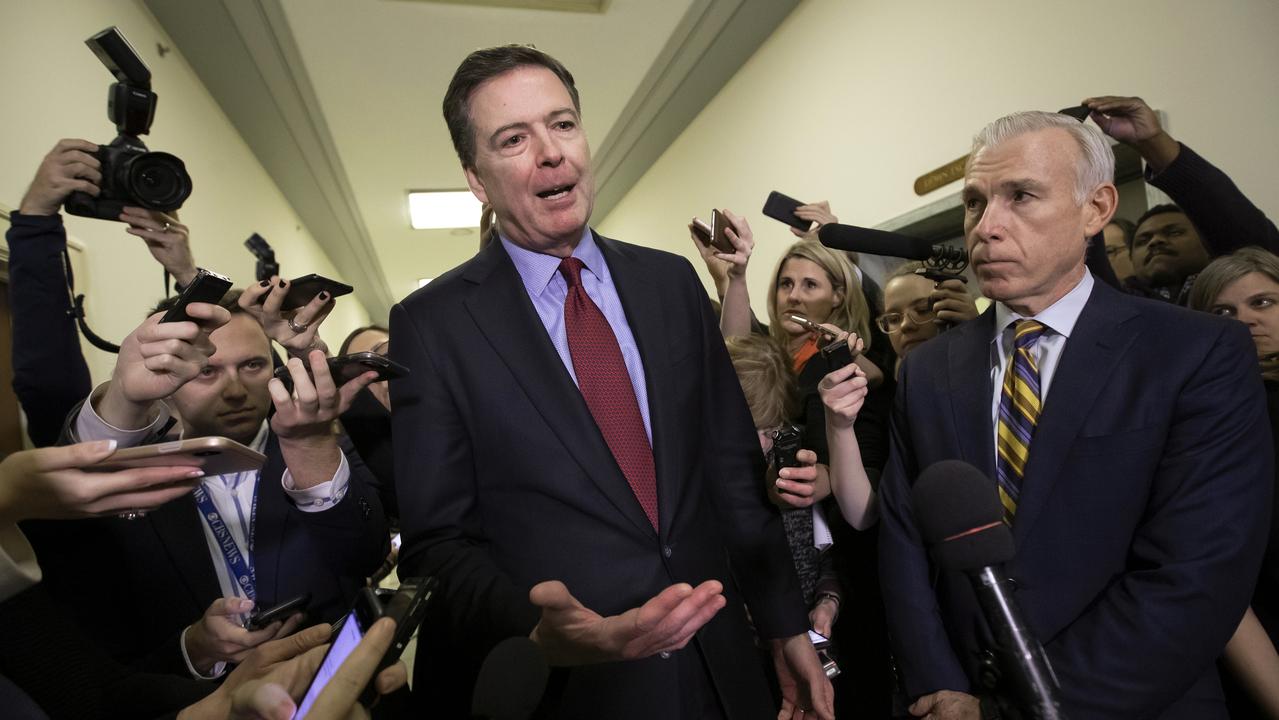
It was approaching first light in Rome on February 19 when Cardinal George Pell was informed a Victoria Police investigation into sexual abuse allegations against him was about to be made public.
As his team carefully considered the predicament, crowds were starting to gather in the 5C cold for their Vatican pilgrimage. Back in Australia, the attention was turning to the weekend.
For Pell and his closest minders — religious and legal — the response to the claims that he had abused between five and 10 boys was as sharp as an Italian suit.
“The allegations are without foundation and are utterly false,” read the statement published by The Australian that night. “The timing of these leaks is clearly designed to do maximum damage to the cardinal and the Catholic Church and undermines the work of the royal commission.”
The statement was a pre-emptive strike to position Pell ahead of an inevitable media fracas, with the church savaging police for (allegedly) leaking the information.
During that weekend, several of Australia’s most senior Catholics united in support of the Vatican’s Prefect of the Secretariat for the Economy, the world’s third most powerful leader of the faith.
While being extensive and targeted, the Pell statement told only part of the story.
For many weeks the church had been aware that the police’s Sano Taskforce was circling Pell, executing warrants to search records and locations connected to his past.
What the church didn’t necessarily know was that it related to allegations that Pell had abused up to 10 children.
At first blush, the allegations seem ludicrous.
Indeed, as The Australian has argued on its editorial pages, Pell deserves the benefit of any doubt; no evidence has been made public to suggest successful criminal proceedings could be launched. However, the revelations of the sex abuse investigation have inflicted extreme damage to Pell’s position, both public and professional.
Jeff Kennett, the former Victorian premier and an admirer of Pell, wrote a strident column backing his eminence in the Herald Sun this week. But it finished with the crucial qualifier: “Until something is proved I will support Cardinal Pell.”
Andrew Bolt wrote of the police bungling in recent years that has included vastly overstating suicide deaths due to clergy abuse in the Ballarat diocese and falsely undermining church efforts to report offending.
Yet his piece, while calling for an end to the “witch-hunt”, conceded, “I cannot say these claims against Pell are false”.
This is to state the obvious but it cuts to the cardinal’s new status.
While it seems likely that police played some role in the leaking of the details of the sex abuse investigations, it is not a certainty that the force was the primary offender in a bid to cut the cardinal down on the eve of his latest royal commission appearance.
To conduct raids on church property, such as St Patrick’s Cathedral in the heart of Melbourne’s Catholic precinct, highly confidential legal documents will have been drawn up and it’s a fair bet they contained reasons the raids were to be undertaken.
The question needs to be asked: who received these documents and who, if anyone, handed them out?
Across the long term, Victoria Police has a poor record on Catholic sex abuse, having been complicit in some cases of concealing offences and, overall, failing miserably to head off crimes as they occurred in the 1960s, 70s and 80s.
The force defended itself this week on whether it was behind the leak. “It concerned me that there was this immediate rush to allege the police have leaked something,” Victoria Police Chief Commissioner Graham Ashton told Melbourne radio station 3AW, adding that the force would “wear it” if it was the source for the original story. “But (it’s) a bit early to snap to rushed conclusions.”
Ashton’s problem is that, after decades of the force dropping the ball on abuse, police have recently overcooked its position, creating a deep split with the church hierarchy, which has worked assiduously in recent years to clean up the mess.
The initial Victorian parliamentary inquiry — and in effect the national royal commission — was triggered by a (false) police claim that scores of victims had killed themselves due to clergy abuse in the Ballarat diocese.
That number was secretly downgraded to just one confirmed case of death by suicide after an internal police inquiry and then it was belatedly corrected only when The Australian discovered a document that was buried miles deep in royal commission submissions.
Ashton, in a previous capacity, also told the Victorian inquiry that the church had not referred a single child abuse allegation to the force.
This was so wildly wrong as to be unbelievable, according to detailed evidence submitted by Peter O’Callaghan QC.
Yet the singling out of Pell and the church persists.
This is perhaps best evidenced by the media’s refusal to confront Pell’s chief accuser, David Ridsdale, who has accused the cardinal of complicity in trying to cover up his uncle’s offending.
He is the nephew of the vile abuser Gerald Ridsdale and suffered terribly at the hands of his priestly uncle.
Unfortunately for all concerned, David Ridsdale went on to become a sex offender himself, a fact the Victorian media conveniently refuses to address.
David Ridsdale is now the defacto spokesman for all victims, with no questioning about his own offending; he has refused to tell The Weekend Australian whether there was more than one victim after he groomed a 12-year-old boy in 1984 and twice exposed himself to him.
Police will not state publicly what Pell is accused of but they have left markers in the investigatory sand.
Just days before Christmas the Sano Taskforce made a rare statement, appealing for information about alleged sexual assaults between 1996 and 2001 at St Patrick’s Cathedral, when the cardinal was archbishop of Melbourne.
St Patrick’s is a minor basilica widely seen as the church’s pre-eminent architectural possession in Australia.
The Age reported on December 23 that search warrants were executed on buildings linked to the church in East Melbourne, Melbourne, Maidstone and Toorak, with the report claiming that 14-year-old youths were sexually assaulted at the church.
The Herald Sun last week linked the Pell investigation to St Patrick’s and altar boys, although the paper may have been referring to members of the choir.
On January 12 in the Ballarat Courier, the taskforce appealed for information about alleged abuse of eight-year-old boys at the regional city’s Eureka Stockade Pool, without naming Pell.
“Police are not focused on any specific user group but rather the children that have been offended against,’’ the force said in a statement, which referred to the years 1977 to 1980.
It is perhaps surprising that these Ballarat allegations hadn’t surfaced earlier.
Pell’s statement of denial was emphatic; he has not offended against children.
Yet he will give evidence to the sex abuse royal commission facing his toughest test since he was forced to stand down as archbishop of Sydney in 2002 over claims he had abused an altar boy at Phillip Island in 1961.
A church inquiry cleared him to return to work, but the complainant nonetheless took some solace from the findings.
As The Weekend Australian reveals today, that Phillip Island investigation has spread to a western suburbs church in Melbourne, with police relying on back to basics document searches.
So where does this leave Pell as he prepares for his final appearance at the royal commission?
The expectation is that Pell will be spared questioning at Rome’s Hotel Quirinale over the sexual assault allegations because of the limitations imposed on the inquiry in relation to criminal investigations.
The church is convinced the commission is gunning for Pell, although the sexual abuse allegations have rendered the inquiry something of a sideshow. As The Australian noted in December, it is quite possible that Pell will be hit hard by the commission, given it is not bound by the “best evidence” rule and is free to admit hearsay evidence.
Having grown up in Ballarat — the location of the worst abusing in Australia — Pell inevitably has been close to many of the key players.
For good reason, there is deep sensitivity around the movement across three decades of serial Ballarat offender Gerald Ridsdale, who sexually assaulted hundreds of children.
Bishop Ronald Mulkearns, who ran the Ballarat diocese from 1971 to 1997, knew of Ridsdale’s offending but failed to act, his performance before the commission this week being both pathetic and lamentable.
While Mulkearns moved Ridsdale around the diocese, Pell was one of the consultors — members of a committee of clergy — who met to OK the movement of Ridsdale, although in reality Pell was probably too junior to count. The move was almost certainly the domain of Mulkearns but it is highly sensitive to victims, who believe Pell protected Ridsdale as evidenced by Pell’s decision to attend court to support Ridsdale in 1993.
It is possible that Pell will face questioning next week over priest Peter Searson, who was a notorious weirdo in the Melbourne parish of Doveton, when Pell was the regional bishop in charge. Searson died in 2009.
Pell received a staff delegation in 1989 from a parish school warning about Searson’s bizarre activities but there is contested evidence about whether Pell acted.
The incumbent Archbishop of Melbourne, Denis Hart, told the commission he would have felt that he should take immediate action if he had received the same delegation.
Pell is also accused of allowing a sex-offending priest to remain in the Catholic system, despite the priest abusing a 16-year-old.
Father Barry Robinson admitted to previous archbishop Frank Little that he had offended against the teenager, but after treatment abroad was given a parish.
As archbishop of Melbourne, Pell signed off on Robinson’s placement as an assistant priest in Melbourne’s west, even though the investigation wasn’t closed until 2005.
Ronald Pickering, who died in 1991, was a notorious priestly sexual abuser who allegedly abused victims both before Pell was archbishop and while he was in the chair in Melbourne.
Pickering escaped justice and died on the run in Britain, with police believing he was a chronic offender across at least three decades. Pell may face questioning over what he did to head off Pickering’s offending.
All the while, the Catholic Church more broadly struggles to recover.
The offending has stopped — as much as it ever will across society — and demand for the church’s schools, hospitals and welfare services continues to soar.
Yet as long as Pell remains under suspicion, the PR problems will continue; it’s the ultimate Catch-22.
Pell deserves the opportunity to defend himself, particularly given there is no publicly available evidence to support the claim of criminal wrongdoing.
But the longer the controversy goes on, the more the church bleeds. The abusers, curse them all, have set the church back generations and the victims rarely, if ever, recover.
Then again, the church’s history on the handling of sex abuse is often beyond belief.
There was barely a ripple this week when the commission heard how the Christian Brothers hired a private investigator in 1995 to gather evidence to investigate victims of a pedophile priest and to gain intelligence on victims’ group Broken Rites.
The Christian Brothers used the PI to help defend Brother Ted Dowlan, who was convicted in 1996 of 16 counts of indecent assault against 11 boys at four schools run by the order.
That story, as extraordinary as it is, received limited coverage in the popular media.
It may have been 20 years ago, but it is a graphic reminder of why trust in the church has been so severely undermined.
That trust will continue to be tested as police work their way through the Pell allegations.





